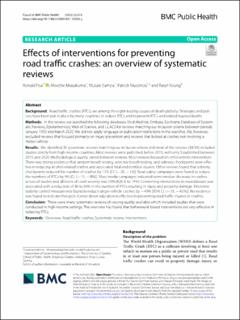| dc.contributor.author | Fisa, Ronald | |
| dc.contributor.author | Musukuma, Mwiche | |
| dc.contributor.author | Sampa, Mutale | |
| dc.contributor.author | Musonda, Patrick | |
| dc.contributor.author | Young, Taryn | |
| dc.date.accessioned | 2022-12-28T09:42:05Z | |
| dc.date.available | 2022-12-28T09:42:05Z | |
| dc.date.created | 2022-04-02T15:03:57Z | |
| dc.date.issued | 2022 | |
| dc.identifier.issn | 1471-2458 | |
| dc.identifier.uri | https://hdl.handle.net/11250/3039613 | |
| dc.description.abstract | Background
Road traffic crashes (RTCs) are among the eight-leading causes of death globally. Strategies and policies have been put in place by many countries to reduce RTCs and to prevent RTCs and related injuries/deaths.
Methods
In this review, we searched the following databases Ovid Medline, Embase, Cochrane Database of Systematic Reviews, Epistemonikos, Web of Science, and LILACS for reviews matching our inclusion criteria between periods January 1950 and March 2020. We did not apply language or publication restrictions in the searches. We, however, excluded reviews that focused primarily on injury prevention and reviews that looked at crashes not involving a motor vehicle.
Results
We identified 35 systematic reviews matching our inclusion criteria and most of the reviews (33/35) included studies strictly from high-income countries. Most reviews were published before 2015, with only 5 published between 2015 and 2020. Methodological quality varied between reviews. Most reviews focused on enforcement intervention. There was strong evidence that random breath testing, selective breath testing, and sobriety checkpoints were effective in reducing alcohol-related crashes and associated fatal and nonfatal injuries. Other reviews found that sobriety checkpoints reduced the number of crashes by 17% [CI: (− 20, − 14)]. Road safety campaigns were found to reduce the numbers of RTCs by 9% [CI: (− 11, − 8%)]. Mass media campaigns indicated some median decrease in crashes across all studies and all levels of crash severity was 10% (IQR: 6 to 14%). Converting intersections to roundabouts was associated with a reduction of 30 to 50% in the number of RTCs resulting in injury and property damage. Electronic stability control measure was found to reduce single-vehicle crashes by − 49% [95% CI: (− 55, − 42%)]. No evidence was found to indicate that post-license driver education is effective in preventing road traffic injuries or crashes.
Conclusion
There were many systematic reviews of varying quality available which included studies that were conducted in high-income settings. The overview has found that behavioural based interventions are very effective in reducing RTCs. | en_US |
| dc.language.iso | eng | en_US |
| dc.publisher | BMC | en_US |
| dc.rights | Navngivelse 4.0 Internasjonal | * |
| dc.rights.uri | http://creativecommons.org/licenses/by/4.0/deed.no | * |
| dc.title | Effects of interventions for preventing road traffic crashes: an overview of systematic reviews | en_US |
| dc.type | Journal article | en_US |
| dc.type | Peer reviewed | en_US |
| dc.description.version | publishedVersion | en_US |
| dc.rights.holder | Copyright 2022 The Author(s) | en_US |
| dc.source.articlenumber | 513 | en_US |
| cristin.ispublished | true | |
| cristin.fulltext | original | |
| cristin.qualitycode | 1 | |
| dc.identifier.doi | 10.1186/s12889-021-12253-y | |
| dc.identifier.cristin | 2014823 | |
| dc.source.journal | BMC Public Health | en_US |
| dc.relation.project | Norges forskningsråd: 223269 | en_US |
| dc.identifier.citation | BMC Public Health. 2022, 22, 513. | en_US |
| dc.source.volume | 22 | en_US |
| dc.source.issue | 1 | en_US |

